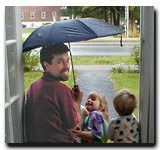You can clean your house from top to bottom without harmful chemicals. The key to a healthy house is keeping it warm and dry in the winter, and cool and dry in the summer. Keeping your relative humidity around 40% is ideal. That level of moisture in the air feels comfortable, but still allows counters, dishes and clothes to air dry. Mold and germs thrive in humid conditions, but none can grow on dry surfaces.
In the winter, your indoor air relative humidity often drops far below 40%. In that case, hanging laundry to dry indoors helps put more moisture in the air. You save money and energy, and make your home more comfortable!
In the summer, your relative humidity can rise above 40%. Running fans in your kitchen and bathroom is a good way to exhaust excess moisture before it leads to mold and mildew problems.
It's important to think not just about the water you're adding to your indoor air, but also what else you're putting into it. Any cleaners that contain petroleum-based fragrances are compromising your indoor air quality and increasing the chances your family will suffer from respiratory disease. Likewise, bleaches and ammonia add unnecessary chemicals to your indoor air and can damage cells in your lungs.
The best "chemical" in your cleaning arsenal is plain water. Plant-based surfactants and acids can help water do a better job of dissolving and rinsing away dirt and grime.
Your decisions about which cleaning chemicals to use have consequences far beyond your own home, especially if you are on a municipal sewer system. The dyes and foaming agents that look pretty in your sink don't look so nice in the Androscoggin River. But even if you are on a septic system, it's important to think about what goes down your drain. Anything that kills germs in your house will also kill the beneficial bacteria that break down your waste. Rather than trying to kill every bacteria in your home (an impossible task), concentrate on removing the dirt, grime and water they need to grow.
One final consideration to bear in mind when buying cleaning supplies is unnecessary packaging. How many 16 ounce spray bottles do you really need? Buying in bulk saves money, cuts down on trips to the store, and keeps literally tons of plastic out of the waste stream. Remember, refills not landfills!
Saturday, March 05, 2011
Green Spring Cleaning - March's Sustainable Living Tip
Labels:
green cleaning,
sustainable living tip
Subscribe to:
Post Comments (Atom)


No comments:
Post a Comment